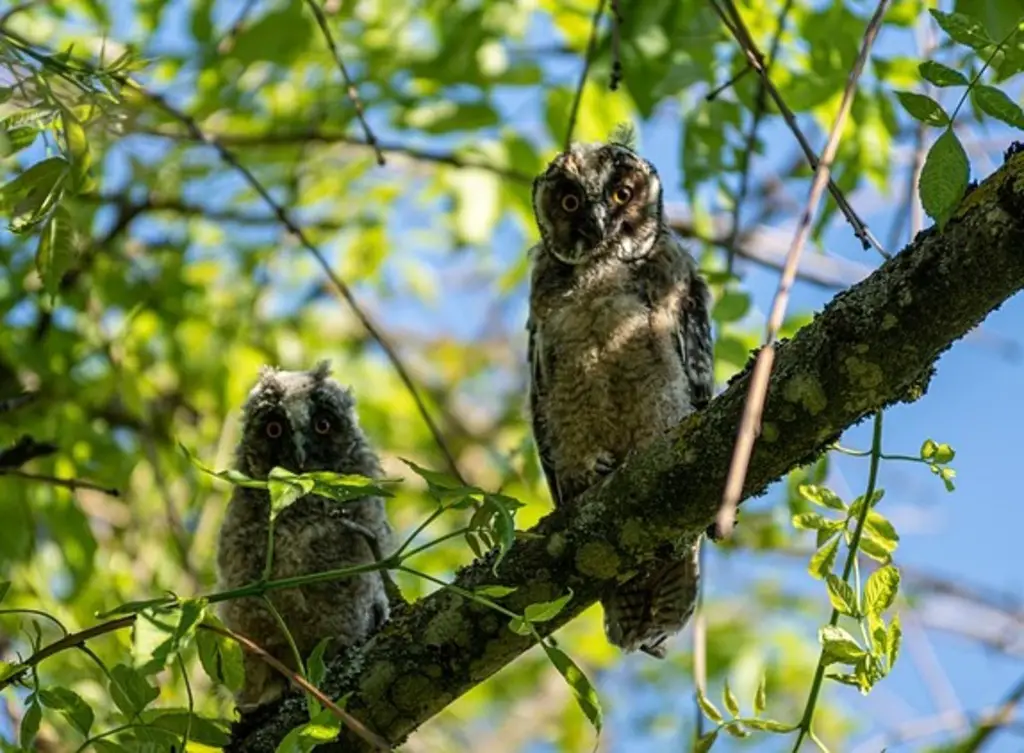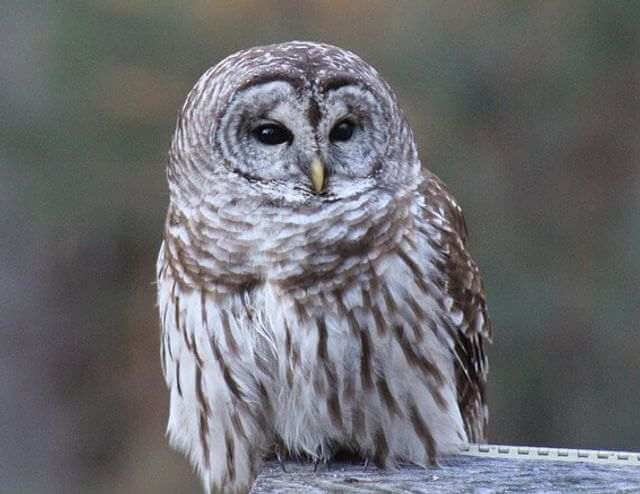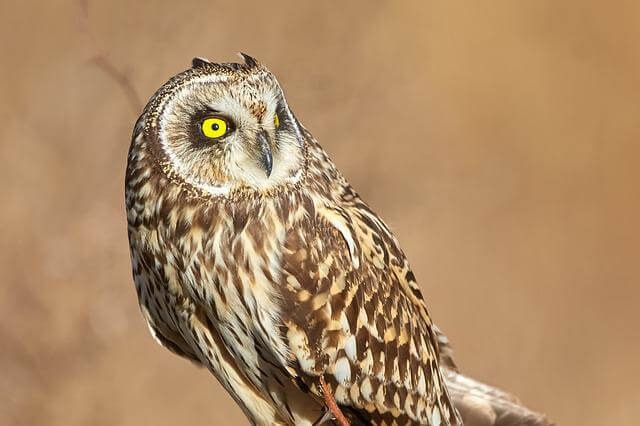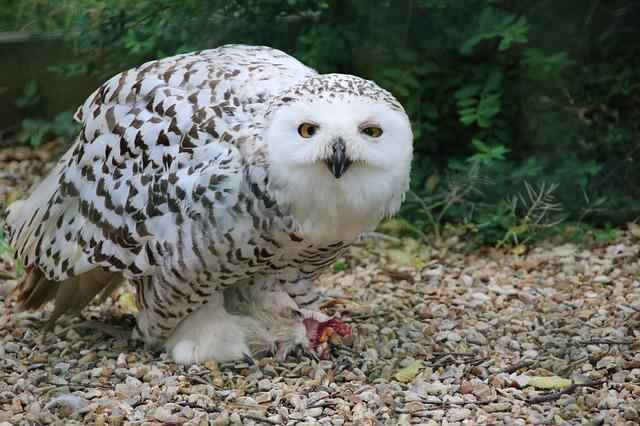Owls are a very diverse and interesting group of birds. In Alabama, there are 10 different types of owls. This is thanks to the many different habitats that Alabama has. Each owl has its own unique call and behavior.
Some of the owls in Alabama are very common, while others are rarer. In this article, we will take a look at the 10 types of owls in Alabama, including photos, ID, frequency of occurrence, and much more.
Table of Contents
Types of Owls in Alabama
Barred Owl
- Length: 16.9-19.7″ in (43-50 cm)
- Weight: 16.6-37.0 oz. (470-1050 g)
- Wingspan: 39.0-43.3″ in (99-110 cm)
- Scientific Name: Strix varia
- Frequency of Occurrence: 2.43% (Statistic by: eBird)
- Where To Find Them: Alabama is known for its natural beauty, and one of the state’s most popular tourist attractions is the Barred Owl. These owls can be seen in a number of locations throughout Alabama, including Bartow County, Calhoun County, Clay County, DeKalb County, Etowah County, Franklin County, Hale County, Jackson County, Lawrence County, Limestone County, Lowndes County, Macon County, Montgomery County, Perry county, Shelby County.
General Information: The barred owl is a large owl that inhabits much of North America. The barred owl ranges from the Arctic tundra to the southernmost part of Texas and Mexico, and can be found in every state except Hawaii. This bird is also found in several Canadian provinces. The barred owl is one of the most common owls in North America, with an estimated population of around 500,000 individuals.
The primary food source for the barred owl is small mammals such as mice and voles, amphibians such as frogs and newts, reptiles such as snakes and lizards, and fish. This bird typically hunts by flying low over its prey and then striking it with its talons.
Great Horned Owl

- Length: 17.7-24.8 in (45-63 cm)
- Weight: 32.1-88.2 oz. (910-2500 g)
- Wingspan: 39.8-57.1 in (101-145 cm)
- Scientific Name: Bubo virginianus
- Frequency of Occurrence: 1.34%
- Where To Find Them: Alabama is home to many different habitats, including deciduous and mixed forests, swamps, and freshwater marshes. One location where you can see the Great Horned Owl is at theNatural Bridge Park in Winston County.
General Information: The Great Horned Owl is the largest owl in North America and can have a wingspan of up to 4.75 feet. They are found mainly in the eastern United States, but they have been documented as far west as California. This owl is found in a variety of habitats, from open grasslands to forests.
They eat small mammals, birds, insects, and reptiles. They are usually solitary animals, but they may form pairs during breeding season. The Great Horned Owl is not considered threatened at this time, but their range could be shrinking due to development and other factors.
Handpicked Related Post: 35 Fun Facts About The Great Horned Owl (Detailed)
Eastern Screech Owl
- Length: 6.3-9.8″ in (16-25 cm)
- Weight: 4.3-8.6 oz. (121-244 g)
- Wingspan: 18.9-24.0″ in (48-61 cm)
- Scientific Name: Megascops asio
- Frequency of Occurrence: 0.4962%
- Where To Find Them: Alabama has several locations where you can see the Eastern Screech Owl. The most common location is in the foothills of the Appalachian Mountains, but you can also see them in northwestern Alabama and southeastern Alabama.
General Information: Eastern Screech Owls are resident breeding birds in the eastern United States. They inhabit a wide range of habitats, from deciduous and mixed forests to suburban areas. These owls are mostly found hunting small mammals, birds, and insects. They are opportunistic hunters that will take whatever is available.
They usually wait until their prey is positioned in a vulnerable position before attacking. Eastern Screech Owls can be quite vocal and produce a loud screeching sound when they hunt or when they defend their territory.
Barn Owl
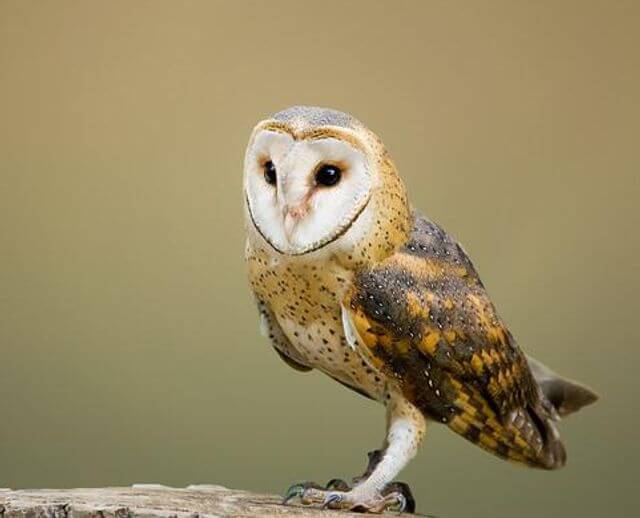
- Length: 12.6-15.8″ in (32-40 cm)
- Weight: 14.1-24.7 oz. (400-700 g)
- Wingspan: 39.4-49.2″ in (100-125 cm)
- Scientific Name: Tyto alba
- Frequency of Occurrence: 0.0953%
- Where To Find Them: Birmingham Botanical Gardens: Located in Birmingham, this garden is home to a variety of different plants and trees, as well as a small pond where you can see the Barn Owl. Great Smoky Mountains National Park: This national park is home to many different types of wildlife, including the Barn Owl. You can find them living in dense forests or perched high up in trees. Hays Nature Preserve: This center is located near Huntsville and features a variety of habitats, including oak woods and an old growth forest. Here you can see the Barn Owl as well as other wildlife such as raccoons and opossums.
General Information: The barn owl is a common sight in many parts of the world, and for good reason- this medium-sized owl is an expert at hunting. This bird ranges across North America, Europe, Asia and Africa, and can be found in a variety of habitats including farmlands, forests, grasslands and deserts. Barn owls are primarily hunters of small mammals, birds and insects, but they will also consume small reptiles if available.
Barn owls are very fast fliers and can often be seen hovering above prey before diving down to capture it. They typically hunt at night but will eat during the day if food is available. Barn owls typically consume small prey items that they catch with their talons.
Short-eared Owl
- Length: 13.4-16.9 in (34-43 cm)
- Weight: 7.3-16.8 oz. (206-475 g)
- Wingspan: 33.5-40.5 in (85-103 cm)
- Scientific Name: Asio flammeus
- Frequency of Occurrence: 0.0136%
- Where To Find Them: Locations in Alabama where you can see the Short-eared Owl include the Talladega National Forest and Noccalula Falls Park.
General Information: The Short-eared Owl is a small owl that ranges throughout much of North America. They are typically found in open areas with plenty of trees and tall vegetation, such as forests and mountainous regions. There are also plenty of them in suburban regions.
The Short-eared Owl is principally a predator of small mammals, birds, insects, and reptiles. They primarily eat small prey which they catch with their sharp talons. They can eat up to 50% of their body weight each day! This owl is said to be one of the most efficient predators in the animal kingdom.
Burrowing Owl
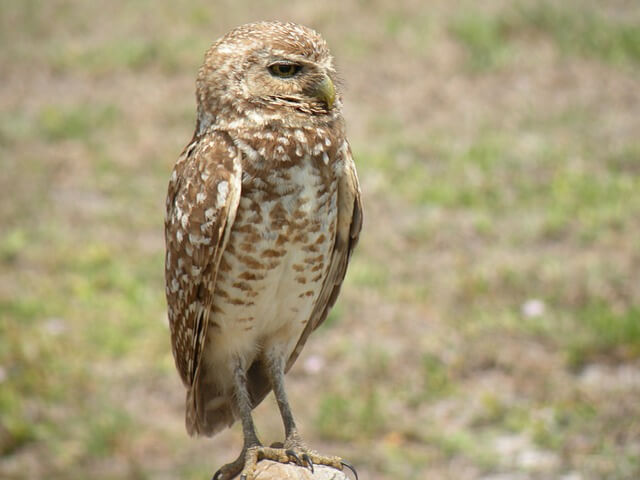
- Length: 7.5-9.8″ in (19-25 cm)
- Weight: 5.3 oz. (150 g)
- Wingspan: 21.6″ in (55 cm)
- Scientific Name: Athene cunicularia
- Frequency of Occurrence: 0.0056%
- Where To Find Them: Burrowing Owls can be found in many locations throughout the state, including the Birmingham Botanical Gardens, Talladega National Forest, and the Key Cave National Wildlife Refuge.
General Information: The Burrowing Owl is a small, nocturnal owl that ranges across much of North America. In the wild, these owls consume small mammals, birds, insects, and reptiles. They are expert diggers and can tunnel through soil as deep as 3 feet.
Burrowing Owls are solitary creatures and rarely interact with other owls or humans. They typically nest in burrows dug by themselves or by their mates during the breeding season. Burrowing Owls are powerful fliers and can stay airborne for up to an hour.
Handpicked Related Post: Really Cool Burrowing Owl Facts That Will Amaze You!
Northern Saw-whet Owl
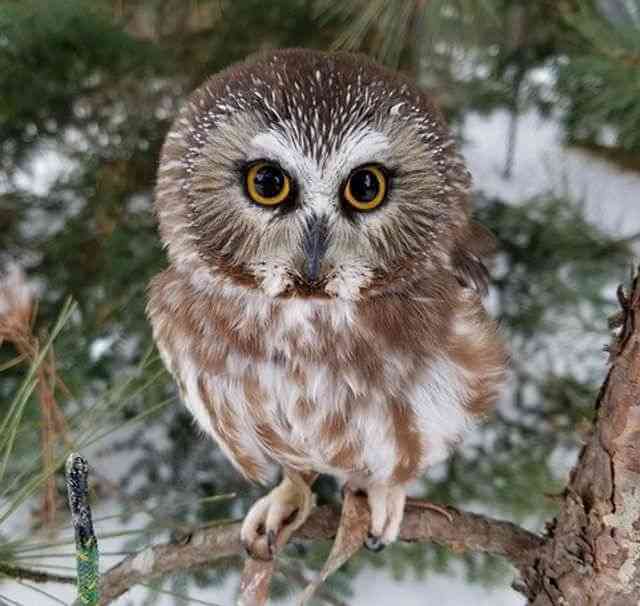
- Length: 7.1-8.3 in (18-21 cm)
- Weight: 2.3-5.3 oz. (65-151 g)
- Wingspan: 16.5-18.9 in (42-48 cm)
- Scientific Name: Aegolius acadicus
- Frequency of Occurrence: 0.0021%
- Where To Find Them: Northern Saw-whet Owl sightings are fairly common in Alabama, especially in the upland areas near the Tennessee border. The owl can also be found throughout the state, but is more abundant in the southern half. Because it’s a shy bird and often hides during the day, spotting one may require some luck.
General Information: The Northern Saw-whet Owl is a small owl commonly known for its occurrence in the boreal forests of North America. This owl is found in Canada, Alaska, and the northern United States. The owls range varies depending on the region, but it typically inhabits areas with dense forest canopy. The owls diet consists mainly of small mammals, birds, insects, and reptiles.
Northern Saw-whet Owls are shy animals and will typically avoid human interaction. They are good hunters and can capture prey that is much larger than they are. Owls are excellent hunters of nighttime prey because their eyesight is very good in low light conditions.
Handpicked Related Post: What is the Smallest Owl in North America?
Flammulated Owl
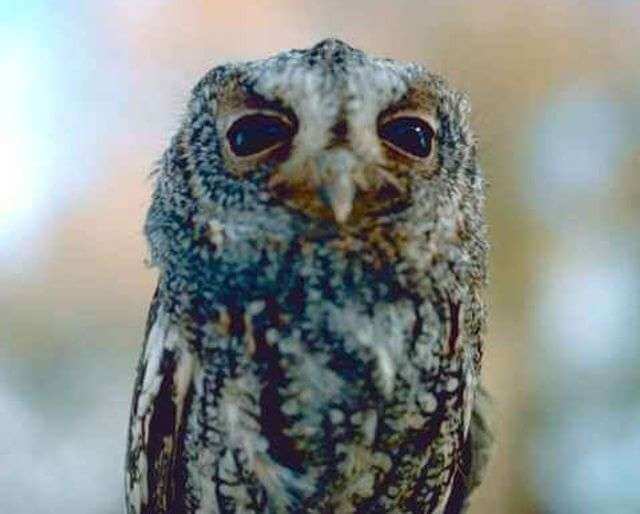
- Length: 5.9-6.7 in (15-17 cm)
- Weight: 1.5-2.2 oz (43-63 g)
- Wingspan: 15.9-16.1 in (40.5-41 cm)
- Scientific Name: Psiloscops flammeolus
- Frequency of Occurrence: 0.0001%
- Where To Find Them: Some locations in Alabama that you can see the Flammulated Owl are Tuscaloosa County, Montgomery County, and Shelby County.
General Information: The Flammulated Owl is a small owl found in the southwestern United States and northern Mexico. It breeds in the desert Southwest, but also ranges east to the Great Lakes region and south to central Brazil. It occurs in open country with sparse vegetation, including arid deserts, chaparral, grasslands, and woodlands.
The diet consists mainly of insects, small mammals (especially rabbits), and birds (particularly songbirds). This owl is not typically shy and is often seen hunting on the ground or in low trees.
Snowy Owl
- Length: 20.5-27.9 in (52-71 cm)
- Weight: 56.4-104.1 oz. (1600-2950 g)
- Wingspan: 49.6-57.1 in (126-145 cm)
- Scientific Name: Bubo scandiacus
- Frequency of Occurrence: 0.0001%
- Where To Find Them: There are a few locations in Alabama that you can spot the Snowy Owl. The best place to see them is in the Appalachian Mountains, specifically in the Ozark and White Mountain National Forests.Another great location is atEufaula National Wildlife Refuge.
General Information: The Snowy Owl is a relatively large owl that can be found in the boreal forests of North America. It feeds primarily on small mammals, birds, and insects but will also consume reptiles. The Snowy Owl’s range extends from central Alaska to southern Canada and includes parts of the United States as well.
The Snowy Owl is a nocturnal bird that roosts in large trees during the day. It has a long, broad wingspan and is very agile in flight. The Snowy Owl is monogamous, and mates for life, and typically has a clutch size of three to eleven chicks per year.
Handpicked Related Post: 48 Fun Facts About Snowy Owls (with Photos, ID & Info)
Long-eared Owl
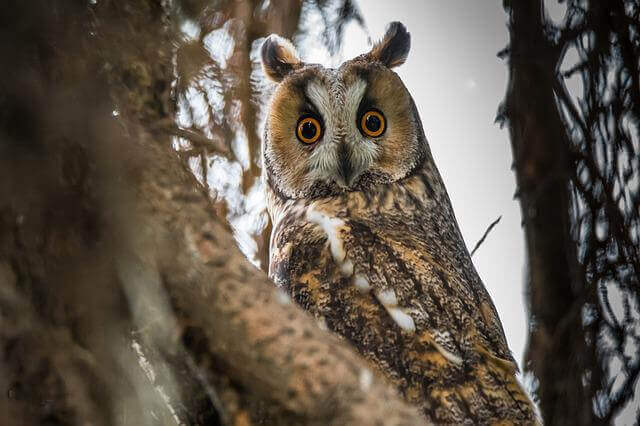
- Length: 13.8-15.8 in (35-40 cm)
- Weight: 7.8-15.3 oz. (220-435 g)
- Wingspan: 35.4-39.4 in (90-100 cm)
- Scientific Name: Asio otus
- Frequency of Occurrence: 0.0001%
- Where To Find Them: The owl is commonly found in the Appalachian Mountains, but can also be found in the Ozark Mountains and in Florida. Some places you may be able to spot the owl include: Talladega National Forest; Cullman County; Tuskegee Airmen National Historic Site; and Talladega National Forest.
General Information: The Long-eared Owl is a medium-sized owl that typically has a wingspan of over three feet. This owl is found in almost every part of the world, with the exception of Antarctica. The Long-eared Owl lives in nearly all types of habitats, from dense forests to open fields.
This owl eats mostly small mammals, birds, and insects. However, it will also eat small reptiles if they are available. This owl is very good at hunting because it can fly silently and see well in dark environments.
Related Post: 38 Most Common Birds in Alabama (with Photos, ID & Info)

